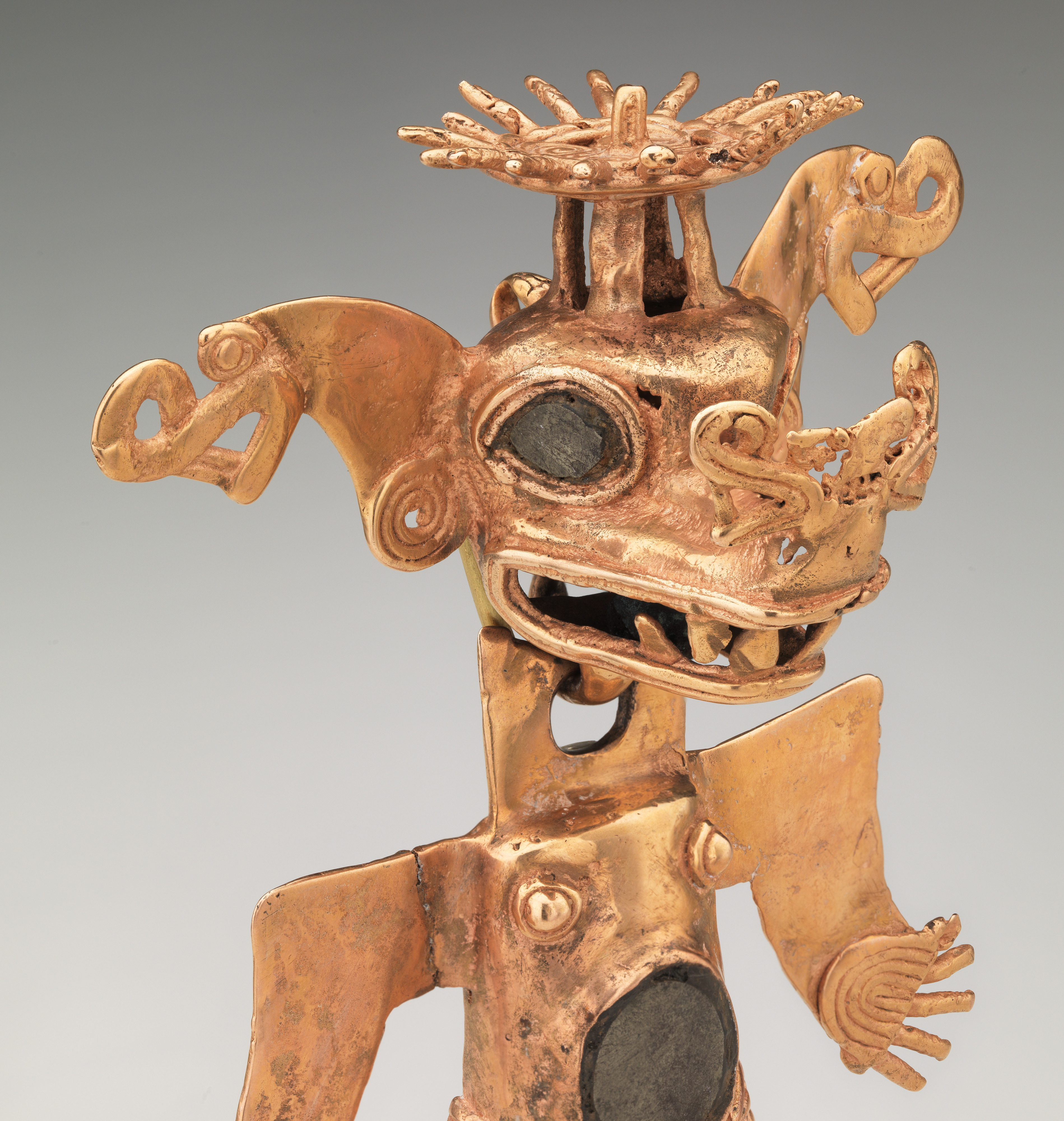Crocodile-Head Figure Pendant
Not on view
This large pendant takes the form of a broad-shouldered standing male with a crocodilian head. The head and body were expertly cast from gold-copper alloy in two pieces using the lost-wax technique. The bipartite work is connected at the neck with a chain-link join. This feature, rare in metal works from the Americas, allows for articulated movement of the body so that it may swing freely from side to side. Reflective pyrite inlays in the torso and eyes are also unusual and add to the crocodilian being’s striking appearance. The figure is also adorned with a braided belt with spherical ornaments.
The outsized visage may represent a mythological being or a human figure wearing a mask. The long snout features an open mouth with jagged teeth protruding from the upper and lower jaw. The nostrils take on an animate form as two smaller stylized crocodiles in profile emerge from either side of the nose. Larger stylized crocodiles that protrude from spiral ear ornaments echo the smaller open jaws. Crocodilian imagery and adornment appear frequently in gold pendants from Costa Rica and Panama. The head is crowned with an elaborate headdress composed of four pillars supporting four spirals with spiky protrusions radiating outward. The spherical metal clapper inside the head would have transformed the pendant into a sonorous accessory when worn. The suspension loop on the reverse of the head is thinned where it would have been strung on a cord, suggesting signs of wear before it was buried as a tomb offering.
Circular plaques of slate covered in mosaic pyrite mirrors, such as the one depicted on the figure here, are common in Mesoamerica. Several of these objects were imported by residents of ancient Costa Rica and Panama (Finamore and Houston, eds. 2009: pp. 147-148; Gallego and Blainey, eds. 2016; Lothrop 1937: p. 102-105, figs. 68, 69; Stone and Balser 1965, pp. 310-329). At Sitio Conte, Panama, archaeologists recovered a gold figural pendant, described as a "mirror frame," with similar inlays that presumably once contained pyrite that had almost completely degraded (Lothrop 1937: p. 105, frontis h, fig. 71). Costa Rican and Panamanian rulers may have suspended these rare, imported objects above their torsos as radiant accessories to ritual regalia, just as depicted on this pendant.
This pendant may be one of the many funerary offerings reportedly recovered in 1962 in southern Costa Rica, on an uncultivated plot of land controlled by United Fruit Company, near the town of Puerto González Víquez on the Burica Peninsula. A prospector with a legal permit uncovered a rich burial and subsequent illicit excavations continued until Carlos Balser from the Museo Nacional de Costa Rica arrived to acquire the works for the national collection. One such gold object described from the find was a large avian pendant, now in the Museo del Oro Precolombino del Banco Central de Costa Rica (no. 1247), whose head was attached with an identical join to that of The Met’s work (Costa Rica: Vanishing Treasure. TIME, October 12, 1962, Latin American Edition. pp. 22-23. Abel Vidor et al. 1981: cat. 291).
James Doyle
References
Abel-Vidor, Suzanne, et al. 1981. Between Continents/Between Seas: Pre-Columbian Art of Costa Rica. New York: Harry N. Abrams.
Finamore, Daniel, and Stephen Houston, eds. 2010. Fiery Pool: The Maya and the Mythic Sea. Salem, Peabody Essex Museum.
Gallego M., Emiliano and Marc G. Blainey, eds. 2016. Manufactured Light: Mirrors in the Mesoamerican Realm. Boulder: University Press of Colorado
Lothrop, Samuel. 1937. Coclé: an Archaeological Study of Central Panama. Part I: Historical Background Excavation sat the Sitio Conte, Artifacts and Ornaments. Memoirs of the Peabody Museum of Archaeology and Ethnology, Harvard University, Vol. VII. Cambridge, Peabody Museum of Archaeology and Ethnology.
Stone, Doris Z., and Carlos Balser. 1965. Incised Slate Disks from the Atlantic Watershed of Costa Rica. American Antiquity 30(3): 310-329.
Exhibitions
"Masterpieces from the Americas." Museum of Primitive Art, New York. May 20–Nov. 11, 1964.
"The World of Primitive Art." Museum of Primitive Art, New York. July 12–Sept. 11, 1966
"Selections from the Museum Collection." Museum of Primitive Art, New York. Sept. 13, 1967–Feb. 4, 1968.
"The gold of Ancient America: Masterpieces from the Pre-Columbian world." Boston Museum of Fine Arts. Dec. 1, 1968–Jan. 12, 1969; Art Institute Chicago. Feb. 1–March 9, 1969; Richmond Museum of Fine Arts. March 24–April 20, 1969.
"Art of Oceania, Africa, and the Americas from the Museum of Primitive Art." The Metropolitan Museum of Art, New York. May 10–Sept. 1, 1969.
"The Gold of Ancient America." Leningrad, State Hermitage Museum, Aug. 4–Oct. 1, 1976; Moscow, State Museum of Representational Arts in the Name of Pushkin, Oct. 15–Dec. 15, 1976; Kiev State Historical Museum, Jan. 5–March 1, 1977
Conservation
Reconstruction of right leg with lower alloy gold. Right thigh has punctured hole. Left thumb damage. Nose of animal punctured. One radial missing from headdress.
10/4/65: Repaired break on right arm. Right wrist bent backwards, almost broken right through, secondary crack above big crack. PVA emulsion along break, bent wrist forward to original position. On back: several layers tosa paper/PVA emulsion/wax/resin support on back and front. Toned gold leaf & bronze powder.
Treated by Joseph Nocera, AMNH, 6/66: cleaned and impregnated under vacuum with a type of nylon, Zytel 61 (Dupont). Dissolved in Methanol-Trichlorethylene solution 50-50 by weight. Secured breaks with low melting point lead-type solder (removable).
Due to rights restrictions, this image cannot be enlarged, viewed at full screen, or downloaded.
This artwork is meant to be viewed from right to left. Scroll left to view more.




